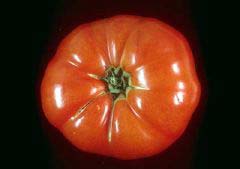Gene Gives Plants a Unique Defense against Disease

Researchers have put a new face on what may be an old genetic weapon to help plants fight off a pesky infection. Abhaya Dandekar and colleagues at the University of California at Davis gave plants an extra gene that protected them from crown gall disease—a scourge of the walnut, grape and rose, among others—when tested in the lab. They publish their findings today in the Proceedings of the National Academy of Sciences.
When the bacterium that causes crown gall disease enters a plant, it starts producing two proteins that help the bug multiply—a phenomenon that leads to cancer in the host. In order to give plants a fighting chance, the researchers engineered strains of the thale cress and the Moneymaker breed of tomato to produce RNA molecules that would inhibit the disease-causing genes. (The tomato pictured here did not come from a plant engineered in this experiment.) Almost all of the transformed plants remained tumor-free after infection with their bacterial foe. This so-called gene-silencing approach, in which one RNA molecule zippers onto a target RNA and shuts it down before it can become a protein, may in fact be an ancient plant defense against certain viruses, Dandekar says. “This whole area is going to provide new ways to combat plant disease,” he predicts.
The crown gall bacterium should find it difficult to rapidly evolve a way around the silencers, the team reports, because the tumor-causing genes are very similar in different strains and would have to change drastically to become resistant. There is also little chance of the resistance genes spreading, Dandekar explains, because the roots and tops of crop plants are typically fused together from different strains, with the roots containing any genetic alterations. The plants could still spread the bacterium, though, the authors note. And like all genetic approaches, Dandekar adds, this one cannot help a field already infested with the disease
Media Contact
All latest news from the category: Life Sciences and Chemistry
Articles and reports from the Life Sciences and chemistry area deal with applied and basic research into modern biology, chemistry and human medicine.
Valuable information can be found on a range of life sciences fields including bacteriology, biochemistry, bionics, bioinformatics, biophysics, biotechnology, genetics, geobotany, human biology, marine biology, microbiology, molecular biology, cellular biology, zoology, bioinorganic chemistry, microchemistry and environmental chemistry.
Newest articles

A chip unique in the world
A team from UPV and iPRONICS has manufactured the first universal, programmable and multifunctional photonic chip on the market. A team from the Photonics Research Laboratory (PRL)-iTEAM of the Universitat…

Advance in light-based computing
…shows capabilities for future smart cameras. UCLA-developed experimental device demonstrates ability to reduce glare in images. Researchers developing the next generation of computing technology aim to bring some light to…

Evidence for reversible oxygen ion movement during electrical pulsing
…enabler of the emerging ferroelectricity in binary oxides. In a recent study published in Materials Futures, researchers have uncovered a pivotal mechanism driving the emergence of ferroelectricity in binary oxides….





















